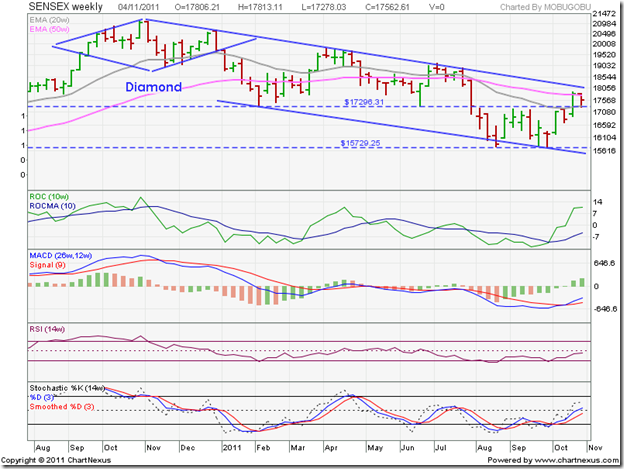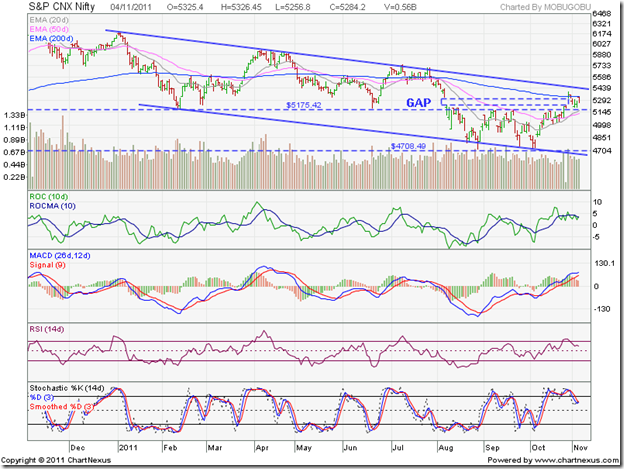One of the interesting challenges of technical analysis is that chart patterns are never static. As patterns evolve with time, one needs to adapt to the changes by rejecting or modifying previous patterns. This may confuse inexperienced observers, but is very much a part of the ‘game’.
The ‘diamond’ reversal patterns formed on both the Sensex and Nifty charts during Oct – Dec 2010 marked the end of the bull rallies from the Mar ‘09 lows. The subsequent patterns appeared to be large descending triangles, from which expected downward break outs occurred with gaps and strong volumes in Aug ‘11.
After 11 weeks of consolidations within rectangular ranges below the descending triangles, the indices climbed up inside the triangles and filled the gap formed in Aug ‘11 over the past two weeks. This has negated the bearish descending triangle, as well as the bullish ‘island reversal’ discussed last week.
BSE Sensex index chart
The past 10 months’ trading – following the break down below the ‘diamond’ reversal pattern – has been redrawn as a downward-sloping channel. Last week’s trading received overhead resistance from the 50 week EMA and support from the 17300 level.
Will the Sensex attempt to break out above the channel next week? The technical indicators are showing bullish signs. The MACD is negative, but is climbing above its signal line. The ROC is positive, but has moved too far above its 10 week MA. The slow stochastic has risen above its 50% level. The RSI is struggling to cross above its 50% level. The bears are likely to put up a fight on any attempted upward break out.
NSE Nifty 50 index chart
The gap on the Nifty chart - marked with a dotted rectangle - was filled during last week’s trading, after the index failed to cross above the 200 day EMA. The possibility of the gap getting filled was mentioned in last week’s post. There are too many macro-economic headwinds for markets to turn bullish. Island reversals are quite rare anyway.
The good news is that the 20 day EMA has crossed above the 50 day EMA, and both have started rising. The bulls may have enough strength to take the index above the 200 day EMA. Any attempt at a break out above the downward-sloping channel is likely to attract selling pressure.
The technical indicators are showing signs of weakness. Both the RSI and the slow stochastic have dropped from their overbought zones, but remain above their 50% levels. The MACD is rising above its signal line in positive territory. The ROC is also positive, but is struggling to cross above its 10 day MA.
Inflation remains stubbornly high despite several interest rate hikes by the RBI. Petrol price hike is not going to help matters. A possible hike in diesel and kerosene will stoke the fire of inflation even more. Only bold policy decisions by the government can turn the situation around. But the government seems more interested in covering up its misdeeds than doing anything constructive. The Greek bailout may provide a temporary boost to global stock markets.
Bottomline? The BSE Sensex and the Nifty 50 index chart patterns are trading within downward-sloping channels. Only a convincing break out above the channels, accompanied by significant increase in volumes, can lead to a change of trend. Till that happens, the down trend will remain in force. It may be better to conserve your cash.


3 comments:
Do u track GMDC? it's going strong in the falling market, what could be the reason? is it because of strong fundamentals? your valuable comments plz. thanks in advance.
Hi Subankar,
The island reversal is off the table as the gap has been fully filled. Is that correct? Are there are any more factors for IR no longer being applicable?
@rf: I'm biased against all PSU stocks - so no comments on GMDC.
@K: As soon as the gaps on the Sensex and Nifty charts got completely filled last week, the 'island reversal's became infructuous. The downward-sloping channels will remain in force till the indices break out of them.
Post a Comment